“Drought” is becoming a far too familiar term in the state of California, where Central Valley farmers are no strangers to the chronic concern as they have felt firsthand the negative effects of a lack of water.
In 2013 California had a record low amount of rainfall and weather experts do not see that improving in 2014, according to the University of California Cooperative Extension. Experts, farmers and the general population alike are hoping for rain in the Valley, and snowfall in the mountains, which will flow down to irrigation reservoirs such as Lake Don Pedro.
“I think it is safe to say that California is in its third year of drought,” said Tim Orvis, director of governmental affairs at the Stanislaus County Farm Bureau. “However, I would say people are concerned, not panicked.”
January is not yet to the half-way point of the rainy season, according to Orvis, who remains hopeful that coming snowfall in the mountains will usher in water to the valley. While water is something every farmer needs, the time of year that the rain falls plays a major role in the development of crops. Ideal rain season for tree crops, such as almonds, is late November to mid-February, which precedes bloom season. Rain at this time of year does not have adverse effects on dormant trees and it also allows the salts, or sodium and chloride in the soil, to be pushed out of the root zone which makes for a better growing environment for the trees.
The dairy industry is also affected by the rainfall due to its impact on ranchers' ability to feed their cows. A lack of rainfall means a lack of growth in forage crops, such as green grass on which the cattle graze, which forces farmers to purchase hay which is not cost effective. Dairy farmers also need rain to fill their stock ponds.
Orvis also reiterated a constant concern in California as he notes that not only do crops need water for growth, but “we all need water for ground water recharge.”
Gov. Jerry Brown met with his recently formed drought task force this week to determine if an emergency declaration is necessary. He said he would "do everything that is humanly possible" to make sure the state's water reserves are used efficiently but noted that even a formal drought declaration has its limits.
"Governors can't make it rain," he told reporters during a briefing on his state budget proposal.
Reservoirs in the state have dipped to historic lows after one of the driest calendar years on record. The first Sierra snow survey of the year last week recorded just 20 percent of average water content for this time of year.
Several communities already have imposed mandatory water reductions. This week, Mendocino County became the first to request state drought assistance, citing an imminent threat of disaster.
U.S. Sen. Dianne Feinstein and Rep. Jim Costa, both Democrats from California, last month called on Brown to immediately declare a drought and to request a broad emergency declaration from President Barack Obama, which would expedite some water transfers, provide financial assistance and suspend some state and federal regulations.
Richard Stapler, a spokesman for the California Natural Resources Agency, said Brown's task force is meeting weekly to address concerns related to the dry conditions and draw up plans for dealing with it. He said specific conditions must be met before an official drought is declared.
"We do have to see how the hydrological circumstances play out for the coming month. That said, you know, the long range forecasts, we're not optimistic," he said.





